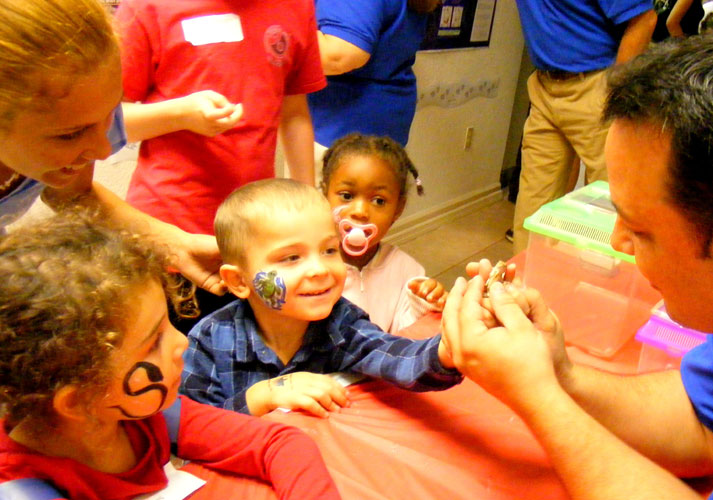
VERO BEACH — There is no better way to celebrate Earth Day than by fostering environmental awareness and appreciation for our natural habitat in the next generation – and that’s exactly what the U.S. Fish and Wildlife Service did at its 3rd Annual Earth Day Open House on Saturday, in conjunction with the Hibiscus Festival.
Nearly 300 visitors of all ages celebrated Earth Day a week early, and delighted in crafts and fossils, a scavenger hunt, interactive wildlife displays, educational exhibits, and even live reptiles.
Four-year-old Amelia Monahan, of Vero Beach, was able to handle a live Brown Anole, and squealed with glee when Student Intern Shawn Christopherson assured her she was handling the small lizard properly.
“See, even if he does bite, it doesn’t hurt,” he said, offering the reptile his finger.
Fisheries Biologist John Galvez, accompanied by a full tank of marine life, discussed the importance of promoting conservation through hands-on learning.
“This helps kids get connected with nature,” he said. “And they love it.”
Scientists were on-hand to answer questions and provide information on endangered species and alternate forms of energy, different pollinators, and also an exhibit on illegal wildlife products, like elephant hair bracelets, sea turtle lotion and the ground-up gallbladder of a bear, all either donated or seized.
“Every day we understand conservation better,” said Field Supervisor Larry Williams. “Awareness has increased in the past 20 years or so. We are making good progress with the Everglades as a whole. Anything can help – even buying a license plate and abiding by Manatee wake zones.”
All proceeds from the sale of Florida conservation plates go to the Florida Fish and Wildlife Conservation Commission.
Bill Burrey and his wife, Carol, on a working holiday from Pennsylvania, said they attended the open house because they love the environment.
“We are interested in learning and having fun doing it – and we have!” he said.
Biologist Trish Adams said she was encouraged by people’s reactions.
“There is certainly more awareness,” she said, referring also to the Commission’s regulatory work for low-impact land development. “We can balance economic goals with the conservation needs of species – and we have success stories right here in Indian River County. It’s win-win, and we strive for that in every consultation, to strike that balance because we realize economic development is important.”
Williams reiterated that there are many conservation success stories.
“We learned the problem and changed how we interact with the environment,” he said, citing water quality improvements, beachfront lighting provisions for sea turtles, and an increase in the number of Florida panthers; an estimated 150, up from just 20 in the 1970’s.
Osprey and eagle populations are also on an up-swing.
“It’s most important for people to know that many native plants and animals are in a perilous position, and whatever people can do to preserve Florida’s natural heritage will help. After all, we are all in this together,” Williams said.



